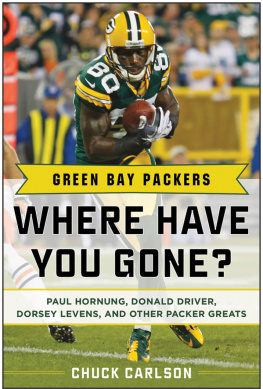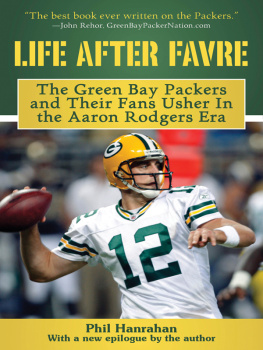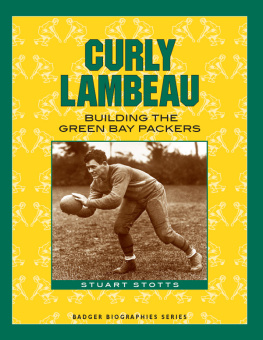Copyright 2015 by Chuck Carlson
All rights reserved. No part of this book may be reproduced in any manner without the express written consent of the publisher, except in the case of brief excerpts in critical reviews or articles. All inquiries should be addressed to Sports Publishing, 307 West 36th Street, 11th Floor, New York, NY 10018.
Sports Publishing books may be purchased in bulk at special discounts for sales promotion, corporate gifts, fund-raising, or educational purposes. Special editions can also be created to specifications. For details, contact the Special Sales Department, Sports Publishing, 307 West 36th Street, 11th Floor, New York, NY 10018 or .
Sports Publishing is a registered trademark of Skyhorse Publishing, Inc., a Delaware corporation.
Visit our website at www.sportspubbooks.com.
10 9 8 7 6 5 4 3 2 1
Library of Congress Cataloging-in-Publication Data is available on file.
Cover design by Tom Lau
Cover photo credit Associated Press
ISBN: 978-1-61321-811-2
Ebook ISBN: 978-1-61321-855-6
Printed in the United States of America
CONTENTS
ACKNOWLEDGMENTS
I t is their inner sanctum, their place of solace and reflection and privacy. No one belongs there unless you belong there.
And most dont because those who understand best know you have to earn your way in there and, more to the point, you have to prove you can stay in there by how you perform.
Its the locker room of professional football players and while it may not exactly be sacred, its at least a place where intruders and interlopers pause before entering.
I know I did. For more than a decade, I poked my nose almost daily into the Green Bay Packers locker room as a sportswriter for the Appleton, Wisconsin, Post-Crescent and nearly every day I paused and looked inside, just to see who was there and, yes, who wasnt.
Even on the best of days and in the best of circumstances, it was never a bargain talking to pro football players in their environment.
After all, they had far better things to do with their time than talk to the media and every one of them knew what time wed be coming in to talk to them about something inane, trivial, or controversial.
So the smart ones made themselves scarce and waited until the media was shuttled out and their locker room belonged only to them again.
But on those days when they were available? It was often gold. Sometimes they would even let their guard down, if only briefly and, if you were lucky, only to you.
All these years later, I still remember talking with the late, great defensive end Reggie White, who spoke as if he were an astronomer discussing the inner workings of the universe when he explained his devastating club move, the forearm shiver he developed that turned offensive tackles into mush.
There was the sight of a young quarterback, Brett Favre, walking into the locker room carrying a bag of Gummi-Bears having just signed a very large, very generous contract extension.
Asked about it he simply smiled and said, It allows me to buy more Gummi-Bears.
Or pensive, unknowable linebacker Wayne Simmons, who discussed his upbringing and future and the meaning of life without knowing hed die in a fiery car wreck a few years later.
These stories, and so many others, endure because, for just a moment, they offer a peek into the hidden corners of a pro athletes life and, just as quickly, that door is slammed shut again.
No admittance; nothing to see here; time to move on.
So when I was asked to write this book Where Have You Gone? about former Green Bay Packers and what theyre up to these days, I figured it would be even more difficult finding these guys. After all, they had no obligations to anyone. The NFL would not fine them for not talking and the team no longer paid their salaries, so they could do what they wanted.
And while I did have my share of issues trying to track down certain players, the task proved less daunting than I had anticipated and for that, I have all those players who talked to me to thank. Most were incredibly gracious as I invaded their privacy one more timebut this time with e-mails, text messages, and phone calls.
They would often ask how much time Id need for the interview and I would say fifteen, maybe twenty, minutes, and most were happy to give me twice that as they headed off in directions about the past that perhaps they didnt even expect. And I am most appreciative to them for that.
I would also like to thank Katie Hermsen of the Green Bay Packers public relations department who did yeoman duty tracing down players and fielding questions for me. Some decided to participate and some didnt but I appreciated Katies efforts nonetheless. Id also like to thank Cliff Christl, the Packers team historian and longtime Milwaukee Journal Sentinel sports writer who was also a huge help.
Id also like to thank Niels Aaboe at Skyhorse Publishing for offering me this opportunityit was different from a lot of books Ive written and came at a time when I didnt think there was anything new for me to learn about this franchise and the guys who played for it. I was wrong. It wasnt an easy project, as I expected, but, then again, nothing worthwhile is.
Finally, Id like to thank my wife Theresa, who did some impressive copy editing, my sons Patrick and Michael who acted as desperately needed technical advisors, and my employers at the Battle Creek Enquirer , especially executive Michael McCullough, who gave me the latitude and time and support to write.
I hope its reflected in what youre about to read.
INTRODUCTION
T he last question asked was the same for every player: Did you leave the game on your terms?
Some laughed. Some paused, as if still trying to formulate an answer or reconcile in their own heads what had happened when the dream ended.
Some knew it was time. Some left still believing they had plenty to offer to some team willing to provide that opportunity.
Some still wonder what happened all those years later. Some were ready to do something else. Some still cant imagine doing anything else.
Indeed, two players used exactly the same phrase several weeks apart and unsolicited.
I didnt leave the game, the game left me.
Indeed, it does that to all pro athletesits just some are better prepared for it than others.
But they all miss it and thats the common thread. Whether theyve been out of football for one year or thirty years, the thrill of the game never leaves them. Its implanted in their DNA and buried in their hearts forever.
Eventually, though, its the body that makes it clear its time to leave and they really did know somewhere inside them. They didnt like it, but they knew it. They knew in ways that only an athlete who knows his body so well can know. And they knew that something had changed.
The mind begins to wander during offseason workouts. Recovery time from a game that used to take two days now took five. Suddenly, the wind sprints were a struggle and the moves they used to make so effortlessly two years earlier were just a little harder now.
Time always wins and every athlete knows it, and its the smart ones who walk away before theyre asked to leave.
For others, injury forced the decision to leave the game they loved. Cruel, unexpected and complete, a shattered leg, a wrecked knee, a bad back and that was it.
Former Packers running back Darrell Thompson remembered looking at the X-ray of his ailing hip and realized he could no longer play.
Just like that.
Another Packers running back, the legendary Paul Hornung, realized his longtime neck injury was so bad that if he didnt heed a doctors warning and retire, he might not walk again.








